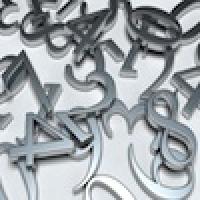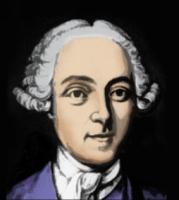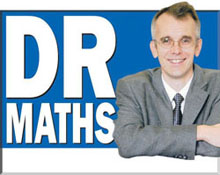
Create your own mathematical mysteries
Leonhard Euler was a Swiss mathematician of the 18th century. His mathematical work was very diverse and he created some beautiful mathematical surprises. (You can read about some of his important discoveries on Plus.) Recently, when reading Pi — Unleashed, I discovered this formula Euler created in 1738 linking the number pi to the primes: $$\frac{\pi}{4}=\frac{3}{4} \times \frac{5}{4} \times \frac{7}{8} \times \frac{11}{12} \times \frac{13}{12} \times \frac{17}{16} \times \frac{19}{20} \times ...$$ You will notice that the numerator of the fractions is always a prime number. In fact all the primes apart from 2 appear as a numerator in this infinite series!
Euler created this formula by expressing Leibniz's infinite series for pi in this new form. Leibniz's formula, developed in 1674, itself provides us with a surprising connection between pi and the odd numbers:
$$\frac {\pi}{4} = \frac{1}{1} - \frac{1}{3} + \frac{1}{5} - \frac{1}{7} + \frac{1}{9} - \frac{1}{11} + \frac{1}{13} - \frac{1}{15} + ...$$
Leonhard Euler
But perhaps the most surprising thing about the primes is that there are a lot of things we don't know about them, for example if there are any patterns in the way they're distributed among the other numbers. Euler found some links and patterns but could not solve this problem. In fact, this mystery is now the subject of one of the Clay Mathematics Institute's Millennium Prize Problems: there is a $1,000,000 prize on offer to anyone who can prove the Riemann Hypothesis which would explain why there are no strong patterns in the primes. But equally you could disprove this famous conjecture (and still win the money) if you can find some underlying pattern which links all the primes. Understanding the distribution of the prime numbers has been one of the holy grails of mathematics for thousands of years and is still an open question. (You can read more about the Riemann Hypothesis and prime numbers on Plus.)
Mathematics is full of such unsolved problems, yet school tends to give us the impression that maths is “done and dusted”, everything has been proved and all the answers are known. Rarely do teachers offer students examples of mathematical conjectures, and students are unlikely to be given the opportunity to discover their own new mathematics. When in fact there are many great unsolved mathematical problems that anyone can explore, and you can even come up with mathematical mysteries of your own.
Mathematical mysteries
A much simpler, but still unsolved, problem which you may like to work on is called the hailstone sequence. A hailstone sequence can be generated from any positive whole number by repeatedly applying this rule: if the number is even, halve it, otherwise if it is odd, triple it and add one.
For example starting with 10, which is even, we divide by 2 to get 5. Five is odd therefore 3x5+1 gives 16. This is even, so halve it to get another even number, 8. Then continuing to follow the rules gives 4, 2 and 1. So the whole sequence starting from 10 is 10, 5, 16, 8, 4, 2, 1. Starting with thirteen gives this sequence; 13, 40, 20, 10, 5, 16, 8, 4, 2, 1.

In fact mathematicians believe that a hailstone sequence will always end up at 1 and call this the Collatz Conjecture, but no one has been able to prove this. Why not test some of your own whole numbers? If you find one which does not work write in and tell me as we will have a proof that this pattern does not always converge to 1! (You can read about the investigations by intrepid Plus work experience students into this problem.)
And not only can you investigate existing mathematical mysteries, you can even discover some of your own! Let's take a look at how new mathematical conjectures can be created in relation to prime numbers, by starting with something known as the Giuga numbers. Guiga numbers are not primes themselves, but they have a very special property. Every whole number is a product of primes, so you can take the recipricals of its prime factors ($1/p$ for each prime factor $p$) and work out their sum and their product. Now subtract the product from the sum — if the answer is a whole number, then the number you started with is a Giuga number. Or mathematically speaking, those numbers $n$ such that the difference $$ \sum_{p \divides n} \frac{1}{p} - \prod_{p\divides n} \frac{1}{p} \in \{1, 2, ...\} . $$
It turns out that Giuga numbers are very rare and the first one doesn't occur until 30. The prime factors of thirty are 2, 3 and 5, and writing the sum and product of the reciprocals of these gives $$ \frac{1}{2}+\frac{1}{3}+\frac{1}{5} - \frac{1}{30} = 1 $$ showing that 30 is a Giuga number. You then have to wait until 858 for the next one: the prime factors of 858 are 2, 3, 11 and 13 giving $$ \frac{1}{2}+\frac{1}{3}+\frac{1}{11}+\frac{1}{13}-\frac{1}{858} = 1. $$ These are the first two of the eleven Giuga numbers which have been found so far. It is still an open question as to whether there are infinitely many of this type of number, or even if there are any odd Giugua numbers which seems quite surprising. (You can find out more about recent mathematical results on Giuga numbers in this paper.)

The exciting thing about Giuga numbers is that they are simple enough for any of us to investigate. Why not satisfy your own curiosity about these intriguing numbers by trying some out yourself? What's more, they also offer an opportunity for creativity by asking the question: “Can other links be made between numbers, primes, factors and fractions?” This question then sets the challenge to discover new maths. To show you what I mean I will develop a class of numbers called….
... The Humble Numbers
We'll define the Humble numbers to be those non-prime numbers $N$ with $n$ prime factors $p_1,... p_n$ that satisfy $$ \frac{1}{p_1}+\sum^n_{i=2}\frac{p_{i-1}}{p_i} +\frac{p_n}{N} - \frac{n+2}{N} = 1. $$ The first Humble number is 6, as $$ \frac{1}{2}+\frac{2}{3}+\frac{3}{6}-\frac{4}{6} = 1. $$ And the next Humble number is 10, as $$ \frac{1}{2}+\frac{2}{5}+\frac{5}{10}-\frac{4}{10} = 1. $$ Why don't you try out a few yourself? You can work them out on paper or with a calculator, but if you get weary you could write a simple computer program to help. (If you need a hand or would like to check how you are doing, you can find a program in BASIC that can be used to investigate the Humble numbers, and a list of the first few Humble numbers in the appendix.)
Playing with these Humble numbers might lead you to make some conjectures of your own:
Are there infinitely many Humble Numbers?
When even Humble Numbers are divided by two is the result always prime?
Do odd Humble Numbers always have factors that are twin primes (a pair of primes that differ by 2)?
Can all twin primes be represented by Humble Numbers?
You might like to start to investigate these questions by solving the following algebraic equations for $N$. You might recognise these equations from your working from the first few Humble numbers: $$ \frac{1}{2}+\frac{2}{p}+\frac{p}{N}-\frac{4}{N}=1 $$ and $$ \frac{1}{p}+\frac{p}{p+2}+\frac{p+2}{N}-\frac{4}{N}=1. $$
Why not create your own number conjectures? Variations in the definition of a Humble number can produce other types of numbers. (The BASIC code in the appendix can be used to investigate Humble Numbers and look for new variations. One such variation can be found by adding the final term, instead of subtracting it, and using the number of prime factors plus one, instead of plus two. For example the number 44 has prime factors 2 and 11 and can be written as $$ \frac{1}{2}+\frac{2}{11}+\frac{11}{44}+\frac{3}{44}=1. $$ The first four numbers which satisfy this new criteria are 44, 80, 902 and 2714.
By encouraging the element of surprise in mathematics we can engage creative mathematical thinking and discovery. Once we believe it is possible for us to search out our own new mathematical conjectures, develop connections and patterns, we lift the secret veil that inhibits people from being involved in the beautifully surprising world of mathematics. What new mathematical surprises can you discover?
About the author

Steve Humble
Steve Humble (aka Dr Maths) works for The National Centre for Excellence in the Teaching of Mathematics in the North East of England. He believes that the fundamentals of mathematics can be taught via practical experiments. For more information on Dr Maths go to the Dr Maths website at the IMA or you can read more in his book, A to Z The Experimeter’s A to Z of Mathematics.
Comments
Anonymous
The hailstone sequence doesn't work for zero.
Anonymous
The hailstone sequence is only defined for positive whole numbers and hence we won't find such sequence if we begin with zero.
developer
This might be not related to the subject in some senses, but is a question in my mind. Browsing Wikipedia and others for understanding a mathematical topic often made me unsatisfied. Because I see that I should read an ambiguously written and hardly symbolized content just to find out the concept while it is already simply understood. Why do mathematicians try making understanding things which are simple too hard? I believe that from those guys there are many love to write just their names on 10 pages full of formulas (completely personalized use of Greek letters) while the simple solution is just writing their names! for introduction. It is simple recently (if not whole the history) mathematicians have serious fear if they provide solutions understandable, they are not knowledgeable! There is a very big but missed difference between symbolization which is for simplification of understanding and demonstrating concepts and encrypting thing.
Anonymous
Surely the Hailstone sequence just picks out an infinite list of even integers and is certain eventually to arrive at a number that is a power of 2, and then it will go to 1. How could it not end up going to 1?
Anonymous
You are probably correct. The point is being able to prove that it will always hit 2^n
mathFan
Anonymous
54 doesn't lead back to 1 just try it.
Anonymous
Try bigger iteration my friend. 113 iteration you will reach the number one (1).
Anonymous
Z> Z =1 / z x z=1 / 1-2-3-4- < 5 = 678 therefore 678 =z+1 -1234
correct?
shashwat singh chauhan &agam agarwal
you know 5.5+5.5 is 11 now change the decimal into addition sign 5+5=10+1= 11 this sequence follows on all odd numbers such as 6.5+6.5=13 then change the operation again 6+5=11+2=13 7.5+7.5=15 7+5=12 +3 = 15
Sunny
The hailstone sequence does not work for the number 101
Marianne
It does work. The sequence is 101, 304, 152, 76, 38, 19, 58, 29, 88, 44, 22, 11, 34, 17, 52, 26, 13, 40, 20, 10, 5, 16, 8, 4, 2, 1.
Aditya8
I have devised a new formula with 2 equal to signs, hence having 3 equations,
Formula.....
x÷a-y÷a=x (2×a)
x is a random positive number
a is a smaller random positive number than x
y is the answer you get by dividing x and a
The second equal to sign comes when u get the answer
Eg:
200÷2-100÷2=200÷(2×2)=50
Thus you see 2 equal to signs and 3 equations. The problem is
Eg:
200÷a-100÷a=200÷(2×a)=50
Trying to find a is almost impossible and I have tried almost all possible ways....if you can solve this and get a=2 then please email me the answer on
adityadadhich16@gmail.com
Thank you!
Joanna
I have recently thought of a formula that produces prime numbers. I haven't fully studied it yet but I have came up with many other different relations as well. For example:
Let n be an odd number
Then
n^2 - (n-1)^2 is a prime
I don't know if anyone have seen this before but I certainly haven't so would love to hear from anyone else who have seen this and similar relations.
Smithmayowa
11^11 - (11-10)^2 = 21 which is not prime.
Himangshu Acharya
Not true
As 5*5-(5-1)(5-1)=9 is not a prime
Piyush
a^3- b^3= a×b×3+(a-b)^2×(a-b)